Fire engine
A fire engine, also known in some places as a fire truck or fire lorry, is a road vehicle (usually a truck) that functions as a firefighting apparatus. The primary purposes of a fire engine include transporting firefighters to an incident as well as carrying equipment for firefighting operations. Some fire engines have specialised functions, such as wildfire suppression and aircraft rescue and firefighting, and may also carry equipment for technical rescue.
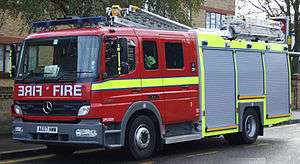
Many fire engines are based on commercial vehicle chassis that are further upgraded and customised for firefighting requirements. They are normally fitted with sirens and emergency vehicle lighting, as well as communication equipment such as two-way radios and mobile computer technology.
The terms fire engine and fire truck are often used interchangeably to a broad range of vehicles involved in firefighting; however, in some fire departments they refer to separate and specific types of vehicle.
Design and construction
The design and construction of fire engines focuses greatly on the use of both active and passive warnings. Passive visual warnings involve the use of high contrast patterns to increase the noticeability of the vehicle. These types of warnings are often seen on older vehicles and those in developing countries.[1] More modern designs make use of retroreflectors to reflect light from other vehicles. Vehicles will also often have these reflectors arranged in a chevron pattern along with the words fire or rescue.[1] European countries commonly use a pattern known as battenburg markings.[2] Along with the passive warnings, are active visual warnings which are usually in the form of flashing colored lights (also known as "beacons" or "lightbars"). These flash to attract the attention of other drivers as the fire truck approaches, or to provide warning to drivers approaching a parked fire truck in a dangerous position on the road. While the fire truck is headed towards the scene, the lights are always accompanied by loud audible warnings such as sirens and air horns.[1]
In some regions, a fire engine may be used to transport first responder firefighters, paramedics or EMTs to medical emergencies due to their proximity to the incident.[3][4]
Types
Conventional fire engine
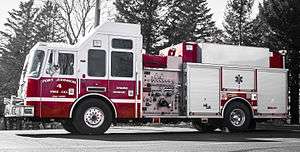 A fire engine of the Fort Johnson Volunteer Fire Company
A fire engine of the Fort Johnson Volunteer Fire Company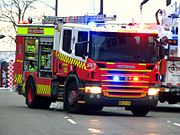 A "pumper" in Australia operated by Fire and Rescue NSW. Note the open compartments on the side of the appliance, containing firefighting equipment.
A "pumper" in Australia operated by Fire and Rescue NSW. Note the open compartments on the side of the appliance, containing firefighting equipment.
The standard fire engine transports firefighters to the scene, provides a limited supply of water with which to fight the fire, and carries equipment needed by the firefighters for most firefighting scenarios. The tools carried on the fire engine will vary greatly based on many factors including the size of the department and the usual situations the firefighters handle. For example, departments located near large bodies of water or rivers are likely to have some sort of water rescue equipment. Standard tools found on nearly all fire engines include ladders, hydraulic rescue tools (often referred to as the jaws of life), floodlights, fire hose, fire extinguishers, self-contained breathing apparatus, and thermal imaging cameras.[5]
The exact layout of what is carried on an engine is decided by the needs of the department. For example, fire departments located in metropolitan areas will carry equipment to mitigate hazardous materials and effect technical rescues, while departments that operate in the wildland-urban interface will need the gear to deal with brush fires.
Some fire engines have a fixed deluge gun, also known as a master stream, which directs a heavy stream of water to wherever the operator points it. An additional feature of engines are their preconnected hose lines, commonly referred to as preconnects.[6] The preconnects are attached to the engine's onboard water supply and allow firefighters to quickly mount an aggressive attack on the fire as soon as they arrive on scene.[6] When the onboard water supply runs out, the engine is connected to more permanent sources such as fire hydrants or water tenders and can also use natural sources such as rivers or reservoirs by drafting water.
Aerial apparatus
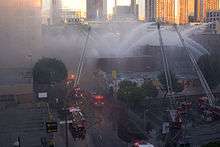
An aerial apparatus is a fire truck mounted with an extendable boom that enables firefighters to reach high locations. They can provide a high vantage point for spraying water and creating ventilation, an access route for firefighters and an escape route for firefighters and people they have rescued. In North America, aerial apparatuses are used for fire suppression, whereas in Europe, they are used more for rescue.[7][8]
Turntable ladder
| Wikimedia Commons has media related to Turntable ladders. |
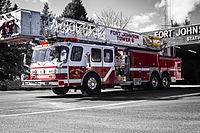 A turntable ladder of the Fort Johnson Volunteer Fire Company
A turntable ladder of the Fort Johnson Volunteer Fire Company- Quint 13 belonging to Fort Lauderdale Fire-Rescue Department
A turntable ladder (TL) is an aerial apparatus with a large ladder mounted on a pivot which resembles a turntable, giving it its name. The key functions of a turntable ladder are allowing access or egress of firefighters and fire victims at height, providing a high-level water point for firefighting (elevated master stream), and providing a platform from which tasks such as ventilation or overhaul can be executed.
To increase its length and reach, the ladder is often telescoping. Modern telescopic ladders may be hydraulic or pneumatic. These mechanical features allow the use of ladders which are longer, sturdier, and more stable. They may also have pre-attached hoses or other equipment.
The pivot can be mounted at the rear of the chassis or in the middle, just behind the cab. The latter is sometimes called a "mid-ship" arrangement, and it allows a lower travel height for the truck.
While the traditional characteristic of a TL was a lack of water pumping or storage, many modern TLs have a water pumping function built in (and some have their own on-board supply reservoir). Some may have piping along the ladder to supply water to firefighters at the top of the ladder, and some of these may also have a monitor installed at the top. Other appliances may simply have a track-way to securely hold a manually-run hose reel.
In the United States, turntable ladders with additional functions such as an onboard pump, a water tank, fire hose, aerial ladder and multiple ground ladders, are known as quad or quint engines, indicating the number of functions they perform.[9]
The highest TL in the world is the Magirus M68L, with a range of 68 meters.[10]
Tiller truck

In the United States, a tiller truck, also known as a tractor-drawn aerial, tiller ladder, or hook-and-ladder truck, is a specialized turntable ladder mounted on a semi-trailer truck. Unlike a commercial semi, the trailer and tractor are permanently combined and special tools are required to separate them. It has two drivers, with separate steering wheels for front and rear wheels.[11]
One of the main features of the tiller-truck is its enhanced maneuverability.[12] The independent steering of the front and back wheels allow the tiller to make much sharper turns, which is particularly helpful on narrow streets and in apartment complexes with maze-like roads.[11] An additional feature of the tiller-truck is that its overall length, over 50 feet (15 m) for most models, allows for additional storage of tools and equipment.[12] The extreme length gives compartment capacities that range between 500 and 650 cubic feet (14 and 18 m3) in the trailer with an additional 40 and 60 cubic feet (1.1 and 1.7 m3) in the cab.[12]
Some departments elect to use tiller-quints, which are tiller trucks that have the added feature of being fitted with an on-board water tank.[12] These are particularly useful for smaller departments that do not have enough personnel to staff both an engine company and a truck company.[12]
Platform truck
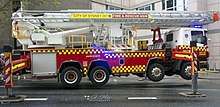 A platform truck in Sydney, Australia
A platform truck in Sydney, Australia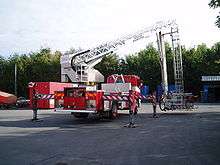
A platform truck carries an aerial work platform, also known as a basket or bucket, on the end of a ladder or boom. These platforms can provide a secure place from which a firefighter can operate. Many platforms also allow for rescues to be performed and are outfitted with tie down clips and rappelling arms.[13]
Some booms are capable of articulating, allowing the arm to bend in one or more places. This allows the platform truck to go "up and over" an obstacle, and is an advantage over the traditional platform ladder, which can only extend in a straight line.
Wildland fire engine

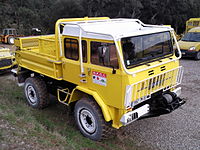
A wildland fire engine is a specialised fire engine that can negotiate difficult terrain for wildfire suppression. A wildland fire engine is smaller than standard fire engines and has a higher ground clearance. They may also respond to emergencies in rough terrain where other vehicles cannot respond. Many wildland engines feature four-wheel drive capability to improve hill climbing and rough terrain capability.[14] Some wildland apparatus can pump water while driving (compared to some traditional engines which must be stationary to pump water), allowing "mobile attacks" on vegetation fires to minimize the rate of spread.[15]
Fire departments that serve areas along the wildland–urban interface have to be able to tackle traditional urban fires as well as wildland fires.[16] Departments in these areas often use a wildland-urban interface engine, which combine features of a standard fire engine with that of a wildland fire engine.[17]
Water tender
 A tender capable of holding up to 7,600 litres (2,000 US gal) of water. This water tender also has a pump.
A tender capable of holding up to 7,600 litres (2,000 US gal) of water. This water tender also has a pump.- A water tender in Hofgeismar, Germany
A water tender is a specialist fire appliance with the primary purpose of transporting large amounts of water to the fire area to make it available for extinguishing operations. These are especially useful in rural areas where fire hydrants are not readily available and natural water resources are insufficient or difficult to exploit.
Most tankers have an on-board pumping system. This pump is often not of sufficient power to fight fires (as it is designed to be attached to a fire engine), but is more often used to draw water into the tender from hydrants or other water sources. Many tankers are equipped with fast-drain valves on the sides and back of the truck. This allows firefighters to empty thousands of gallons of water into a portable water tank in just a few seconds.
Most water tenders are designed to carry loads of 1,000 US gallons (3,800 L; 830 imp gal) or more.
Airport crash tender
.jpg) LBFD Crash 3 responding to a call at Long Beach Airport
LBFD Crash 3 responding to a call at Long Beach Airport.jpg) A Rosenbauer airport crash tender at London Heathrow Airport
A Rosenbauer airport crash tender at London Heathrow Airport
An airport crash tender is a specialized fire engine designed for use at aerodromes in aircraft accidents.[18] Some of the features that make the airport crash tender unique are its ability to move on rough terrain outside the runway and airport area, large water capacity as well as a foam tank, a high-capacity pump, and water/foam monitors. Newer airport crash tenders also incorporate twin agent nozzles/injection systems that add dry chemical fire retardant (such as Purple-K) to create a stream of firefighting foam which is able to stop the fire faster.[19] Some also have gaseous fire suppression tanks for electrical fires. These features give the airport crash tenders a capability to reach an airplane rapidly, and rapidly extinguish large fires with jet fuel involved.
Other vehicles
| Wikimedia Commons has media related to Firefighting command vehicles. |
Other vehicles that are used by fire departments but may not be directly involved in firefighting may include
- Fire car
- Fire investigation unit
- Fire police unit
- Hazardous materials apparatus
- Light and air unit
- Marine rescue unit
- Mobile communications vehicle
- Operational support unit
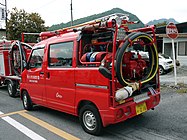
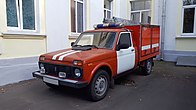 Pickup truck fire engine in Russia
Pickup truck fire engine in Russia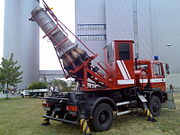 A "Turbo Extinguisher" of the German fire services
A "Turbo Extinguisher" of the German fire services- A fire tank in Germany
History
| Wikimedia Commons has media related to Historical fire engines. |
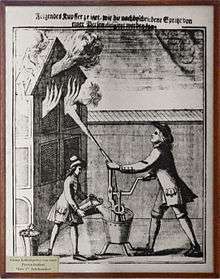
An early device used to squirt water onto a fire was known as a squirt or fire syringe. Hand squirts and hand pumps are noted before Ctesibius of Alexandria invented the first fire pump around the 2nd century B.C.,[20] and an example of a force-pump possibly used for a fire-engine is mentioned by Heron of Alexandria. A book of 1655 inventions mentions a steam engine (called a fire engine) pump used to "raise a column of water 40 feet (12 m)", but there was no mention of whether it was portable.
Colonial laws in America required each house to have a bucket of water on the front stoop in preparation for fires at night. These buckets were intended for use by the initial bucket brigade that would supply the water at fires. Philadelphia obtained a hand-pumped fire engine in 1719, years after Boston's 1654 model appeared there, made by Joseph Jenckes Sr., but before New York's two engines arrived from London.
By 1730, Richard Newsham, in London, had made successful fire engines; he invented the first ones used in New York City (in 1731) (this was six years before formation of the NYC volunteer fire department). The amount of manpower and skill necessary for firefighting prompted Benjamin Franklin to found an organized fire company in 1737. Thomas Lote built the first fire engine made in America in 1743. These earliest engines are called hand tubs because they are manually (hand) powered and the water was supplied by a bucket brigade dumping it into a tub (cistern) where the pump had a permanent intake pipe. An important advancement around 1822 was the invention of an engine which could draft water from a water source. This rendered the bucket brigade obsolete. In 1822, a Philadelphia-based manufacturing company called Sellers and Pennock made a model called "The Hydraulion". It is said to be the first suction engine.[21] Some models had the hard, suction hose fixed to the intake and curled up over the apparatus known as a squirrel tail engine.
The earliest engines were small and were either carried by four men, or mounted on skids and dragged to a fire. As the engines grew larger they became horse-drawn and later self-propelled by steam engines.[22] John Ericsson is credited with building the first American steam-powered fire engine. John Braithwaite built the first steam fire-engine in Britain.
Until the mid-19th century, most fire engines were maneuvered by men, but the introduction of horse-drawn fire engines considerably improved the response time to incidents. The first self-propelled steam pumper fire engine was built in New York in 1841. Unfortunately for the manufacturers, some firefighters sabotaged the device and its use of the first engine was discontinued. However, the need and the utility of power equipment ensured the success of the steam pumper well into the twentieth century. Many cities and towns around the world bought the steam fire engines.
Motorized fire engines did not become commonplace until the early 20th century. By 1905, the idea of combining gas engine motor trucks into fire engines was attracting great attention; according to a Popular Mechanics article in that year,[23] such trucks were rapidly gaining popularity in England. That same year, the Knox Automobile Company of Springfield, Massachusetts, began selling what some[24] have described as the world's first modern fire engine. A year later, the city of Springfield, Illinois, had filled their fire department with Knox engines. Another early motorized fire engine was developed by Peter Pirsch and Sons of Kenosha, Wisconsin. [25]
For many years firefighters sat on the sides of the fire engines, or even stood on the rear of the vehicles, exposed to the elements. This arrangement was uncomfortable and dangerous (some firefighters were thrown to their deaths when their fire engines made sharp turns on the road), and today nearly all fire engines have fully enclosed seating areas for their crews.
Early pumpers
Early pumpers used cisterns as a source of water. Water was later put into wooden pipes under the streets and a "fire plug" was pulled out of the top of the pipe when a suction hose was to be inserted. Later systems incorporated pressurized fire hydrants, where the pressure was increased when a fire alarm was sounded. This was found to be harmful to the system and unreliable. Today's valved hydrant systems are kept under pressure at all times, although additional pressure may be added when needed. Pressurized hydrants eliminate much of the work in obtaining water for pumping through the engine and into the attack hoses. Many rural fire engines still rely upon cisterns or other sources for drafting water into the pumps. Steam pumper came in to use in the 1850s.
Early aerials
In the late 19th century, means of reaching tall structures were devised. At first, manually extendable ladders were used; as these grew in length (and weight), they were put onto two large wheels. When carried by fire engines these wheeled escape ladders had the wheels suspended behind the rear of the vehicle, making them a distinctive sight. Before long, turntable ladders—which were even longer, mechanically extendable, and installed directly onto fire trucks—made their appearances.
After the Second World War turntable ladders were supplemented by the aerial work platform (sometimes called "cherry picker"), a platform or bucket attached onto a mechanically bending arm (or "snorkel") installed onto a fire truck. While these could not reach the height of similar turntable ladders, the platforms could extend into previously unreachable "dead corners" of a burning building.
See also
- Containerized firefighting equipment
- Electric fire engine
- Fire appliances in the United Kingdom
- Glossary of firefighting terms
- Jan van der Heyden
- NFPA 1901
References
- Dallman, Chris. "What Type Of Fire Truck Lights Are Most Effective". 911 Signal USA. Retrieved 17 March 2015.
- "Study Highlights Best Practices for Emergency Vehicle Visibility, Conspicuity". Fire Rescue 1. 15 September 2009. Retrieved 23 February 2018.
- Walter A, Edgar C, Rutledge M: First Responder Handbook: Fire Service Edition.
- Alaspää et al.: Uusi ensihoidon käsikirja. Tammi 2004. (New Handbook on Emergency care) (in Finnish)
- "What is a Fire Engine?". WiseGeek. Retrieved 17 March 2015.
- Leihbacher, Doug (1 April 2000). "Preconnects: The Basics". Fire Engineering Magazine. 153 (4). Retrieved 19 March 2015.
- "United States vs. Europe". Fire Apparatus. 7 June 2016. Retrieved 17 July 2019.
- "Fire Commentary: European Firefighting Operations". Fire Engineering. 12 June 2008. Retrieved 17 July 2019.
- "Glossary". Fire Service Info. Retrieved 5 January 2014.
- "Dosięgnąć nieba czyli M68L, najwyższa na świecie drabina hydrauliczna z windą ratowniczą!" [Reach the Sky or the M68L, the world's tallest hydraulic rescue ladder! "]. remiza.com. Retrieved 19 June 2017.
- Avsec, Robert (23 April 2013). "Pros and cons of tractor-drawn aerials". Fire Recruit. Retrieved 16 March 2015.
- Hines, Charlie. "Fire Apparatus Utilized on Emergency Responses—Benefits of a Tiller". City of San Luis Obispo. Fire Chief. Retrieved 16 March 2015.
- "Platform Features". Ferrara Fire. Archived from the original on 15 March 2015. Retrieved 17 March 2015.
- "Engine Types" (PDF). National Wildfire Coordinating Group. Archived from the original (PDF) on 1 May 2015. Retrieved 5 January 2014.
- "Type 3 Engine" (PDF). Santa Barbara County Fire. Archived from the original (PDF) on 31 December 2013. Retrieved 30 December 2013.
- Wright, Edward (1 August 2012). "Wildland Urban Interface Fires: Managing A Cascade Of Risk". Fire Engineering Magazine. 165 (8). Retrieved 18 March 2015.
- "Wildland Type I & Type II". Ferrara Fire. Archived from the original on 8 April 2015. Retrieved 18 March 2015.
- Petrillo, Alan (29 August 2014). "Protecting Airports with New ARFF Designs and Equipment". Fire Apparatus & Emergency Equipment. 19 (9). Retrieved 17 March 2015.
- Vaccaro, Bob (31 July 2008). "Latest ARFF Apparatus Technology". FireRescue (August 2008). Retrieved 17 March 2015.
- Young, Charles Frederick T.. Fires, fire engines, and fire brigades: with a history of manual and steam fire engines, their construction, use, and management; remarks on fire-proof buildings ... statistics of the fire appliances in English towns; foreign fire systems; hints for the f. London: Lockwood & Co., 1866. 335. Print.]
- Rorer, Beverly, and Barbara Marinelli. Images of America: Upper Darby. Charleston, S.C.: Arcadia Pub., 2011. 112. Print.
- Manchester Locomotive Works first self-propelled Amoskeag Steam Fire Engine. Sold to Boston Fire department after use at Great Boston Fire of 1872 www.bostonfiremuseum.com, accessed 6 August 2020
- Editorial staff (February 1905), "Motor fire engines popular in England", Popular Mechanics, 7 (2): 202.
- "Books about Knox Automobile Company—Historical Photos & Images of Knox Automobile Company". Arcadia Publishing. Retrieved 24 October 2011.
- The American Peoples Encyclopedia Yearbook: Events and Personalities. Spencer Press. 1955. p. 77.
External links
| Wikimedia Commons has media related to Fire engines. |
- The development of United States fire engines
- Detailed examination of two fire trucks
- Large image library and forum with thousands of photos of old and modern fire engines / trucks
- Handtub Junction, USA Website about handtubs in the U.S. including a database of all known apparatus.
- A brief, concise history of fire fighting apparatus
- Video of slowly setting up to pump a restored 1868 Button hand pumper
- Fire engines staffed by 1 or 2 people